Finite-length transmission lines
A transmission line of infinite length is an
interesting abstraction, but physically impossible. All
transmission lines have some finite length, and as such do
not behave precisely the same as an infinite line. If that
piece of 50 Ω "RG-58/U" cable I measured with an ohmmeter
years ago had been infinitely long, I actually would have
been able to measure 50 Ω worth of resistance between the
inner and outer conductors. But it was not infinite in
length, and so it measured as "open" (infinite resistance).
Nonetheless, the characteristic impedance
rating of a transmission line is important even when dealing
with limited lengths. An older term for characteristic
impedance, which I like for its descriptive value, is
surge impedance. If a transient voltage (a "surge") is
applied to the end of a transmission line, the line will
draw a current proportional to the surge voltage magnitude
divided by the line's surge impedance (I=E/Z). This simple,
Ohm's Law relationship between current and voltage will hold
true for a limited period of time, but not indefinitely.
If the end of a transmission line is
open-circuited -- that is, left unconnected -- the current
"wave" propagating down the line's length will have to stop
at the end, since electrons cannot flow where there is no
continuing path. This abrupt cessation of current at the
line's end causes a "pile-up" to occur along the length of
the transmission line, as the electrons successively find no
place to go. Imagine a train traveling down the track with
slack between the rail car couplings: if the lead car
suddenly crashes into an immovable barricade, it will come
to a stop, causing the one behind it to come to a stop as
soon as the first coupling slack is taken up, which causes
the next rail car to stop as soon as the next coupling's
slack is taken up, and so on until the last rail car stops.
The train does not come to a halt together, but rather in
sequence from first car to last:
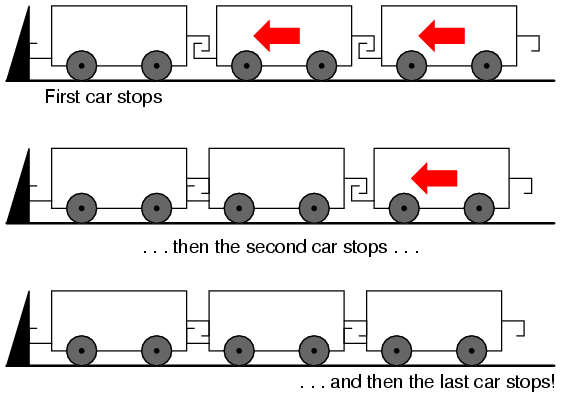
A signal propagating from the source-end of
a transmission line to the load-end is called an incident
wave. The propagation of a signal from load-end to
source-end (such as what happened in this example with
current encountering the end of an open-circuited
transmission line) is called a reflected wave.
When this electron "pile-up" propagates back
to the battery, current at the battery ceases, and the line
acts as a simple open circuit. All this happens very quickly
for transmission lines of reasonable length, and so an
ohmmeter measurement of the line never reveals the brief
time period where the line actually behaves as a resistor.
For a mile-long cable with a velocity factor of 0.66 (signal
propagation velocity is 66% of light speed, or 122,760 miles
per second), it takes only 1/122,760 of a second (8.146
microseconds) for a signal to travel from one end to the
other. For the current signal to reach the line's end and
"reflect" back to the source, the round-trip time is twice
this figure, or 16.292 �s.
High-speed measurement instruments are able
to detect this transit time from source to line-end and back
to source again, and may be used for the purpose of
determining a cable's length. This technique may also be
used for determining the presence and location of a
break in one or both of the cable's conductors, since a
current will "reflect" off the wire break just as it will
off the end of an open-circuited cable. Instruments designed
for such purposes are called time-domain reflectometers
(TDRs). The basic principle is identical to that of sonar
range-finding: generating a sound pulse and measuring the
time it takes for the echo to return.
A similar phenomenon takes place if the end
of a transmission line is short-circuited: when the voltage
wave-front reaches the end of the line, it is reflected back
to the source, because voltage cannot exist between two
electrically common points. When this reflected wave reaches
the source, the source sees the entire transmission line as
a short-circuit. Again, this happens as quickly as the
signal can propagate round-trip down and up the transmission
line at whatever velocity allowed by the dielectric material
between the line's conductors.
A simple experiment illustrates the
phenomenon of wave reflection in transmission lines. Take a
length of rope by one end and "whip" it with a rapid
up-and-down motion of the wrist. A wave may be seen
traveling down the rope's length until it dissipates
entirely due to friction:
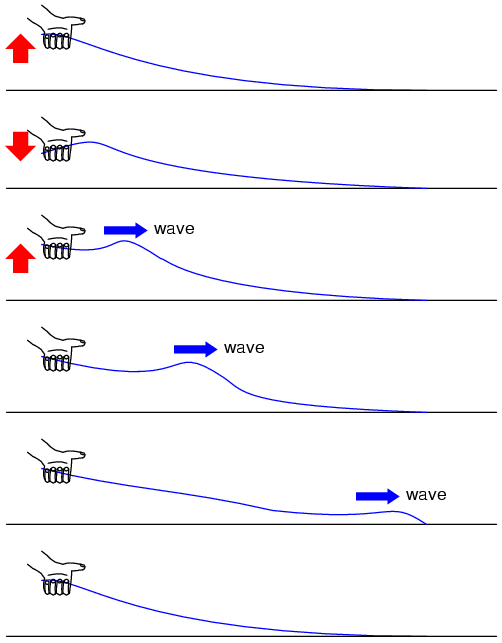
This is analogous to a long transmission
line with internal loss: the signal steadily grows weaker as
it propagates down the line's length, never reflecting back
to the source. However, if the far end of the rope is
secured to a solid object at a point prior to the incident
wave's total dissipation, a second wave will be reflected
back to your hand:
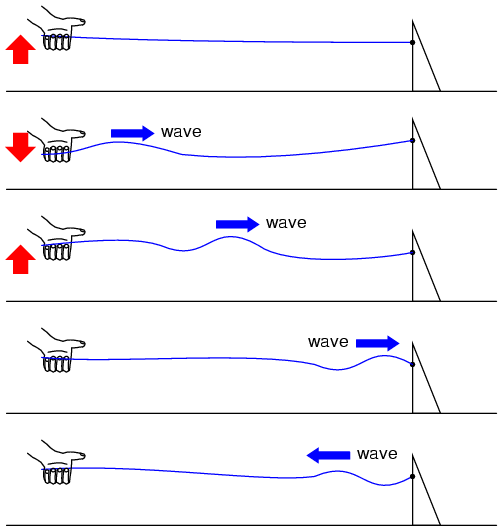
Usually, the purpose of a transmission line
is to convey electrical energy from one point to another.
Even if the signals are intended for information only, and
not to power some significant load device, the ideal
situation would be for all of the original signal energy to
travel from the source to the load, and then be completely
absorbed or dissipated by the load for maximum
signal-to-noise ratio. Thus, "loss" along the length of a
transmission line is undesirable, as are reflected waves,
since reflected energy is energy not delivered to the end
device.
Reflections may be eliminated from the
transmission line if the load's impedance exactly equals the
characteristic ("surge") impedance of the line. For example,
a 50 Ω coaxial cable that is either open-circuited or
short-circuited will reflect all of the incident energy back
to the source. However, if a 50 Ω resistor is connected at
the end of the cable, there will be no reflected energy, all
signal energy being dissipated by the resistor.
This makes perfect sense if we return to our
hypothetical, infinite-length transmission line example. A
transmission line of 50 Ω characteristic impedance and
infinite length behaves exactly like a 50 Ω resistance as
measured from one end. If we cut this line to some finite
length, it will behave as a 50 Ω resistor to a constant
source of DC voltage for a brief time, but then behave like
an open- or a short-circuit, depending on what condition we
leave the cut end of the line: open or shorted. However, if
we terminate the line with a 50 Ω resistor, the line
will once again behave as a 50 Ω resistor, indefinitely: the
same as if it were of infinite length again:
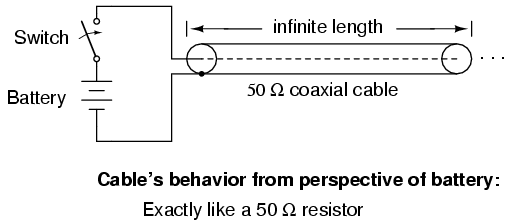
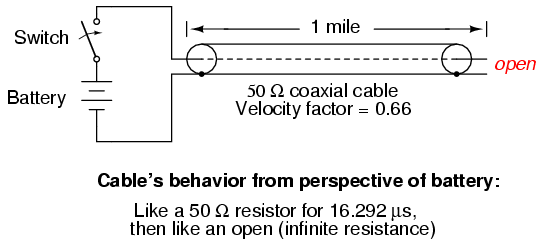
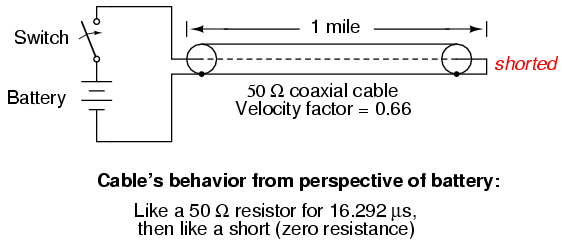
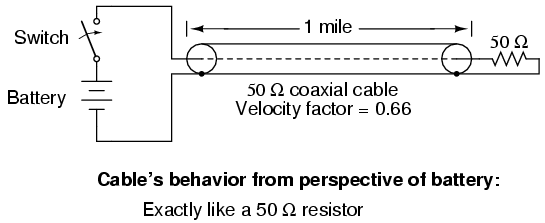
In essence, a terminating resistor matching
the natural impedance of the transmission line makes the
line "appear" infinitely long from the perspective of the
source, because a resistor has the ability to eternally
dissipate energy in the same way a transmission line of
infinite length is able to eternally absorb energy.
Reflected waves will also manifest if the
terminating resistance isn't precisely equal to the
characteristic impedance of the transmission line, not just
if the line is left unconnected (open) or jumpered
(shorted). Though the energy reflection will not be total
with a terminating impedance of slight mismatch, it will be
partial. This happens whether or not the terminating
resistance is greater or less than the line's
characteristic impedance.
Re-reflections of a reflected wave may also
occur at the source end of a transmission line, if
the source's internal impedance (Thevenin equivalent
impedance) is not exactly equal to the line's characteristic
impedance. A reflected wave returning back to the source
will be dissipated entirely if the source impedance matches
the line's, but will be reflected back toward the line end
like another incident wave, at least partially, if the
source impedance does not match the line. This type of
reflection may be particularly troublesome, as it makes it
appear that the source has transmitted another pulse.
-
REVIEW:
-
Characteristic impedance is also known as
surge impedance, due to the temporarily resistive
behavior of any length transmission line.
-
A finite-length transmission line will
appear to a DC voltage source as a constant resistance for
some short time, then as whatever impedance the line is
terminated with. Therefore, an open-ended cable simply
reads "open" when measured with an ohmmeter, and "shorted"
when its end is short-circuited.
-
A transient ("surge") signal applied to
one end of an open-ended or short-circuited transmission
line will "reflect" off the far end of the line as a
secondary wave. A signal traveling on a transmission line
from source to load is called an incident wave; a
signal "bounced" off the end of a transmission line,
traveling from load to source, is called a reflected
wave.
-
Reflected waves will also appear in
transmission lines terminated by resistors not precisely
matching the characteristic impedance.
-
A finite-length transmission line may be
made to appear infinite in length if terminated by a
resistor of equal value to the line's characteristic
impedance. This eliminates all signal reflections.
-
A reflected wave may become re-reflected
off the source-end of a transmission line if the source's
internal impedance does not match the line's
characteristic impedance. This re-reflected wave will
appear, of course, like another pulse signal transmitted
from the source.
|